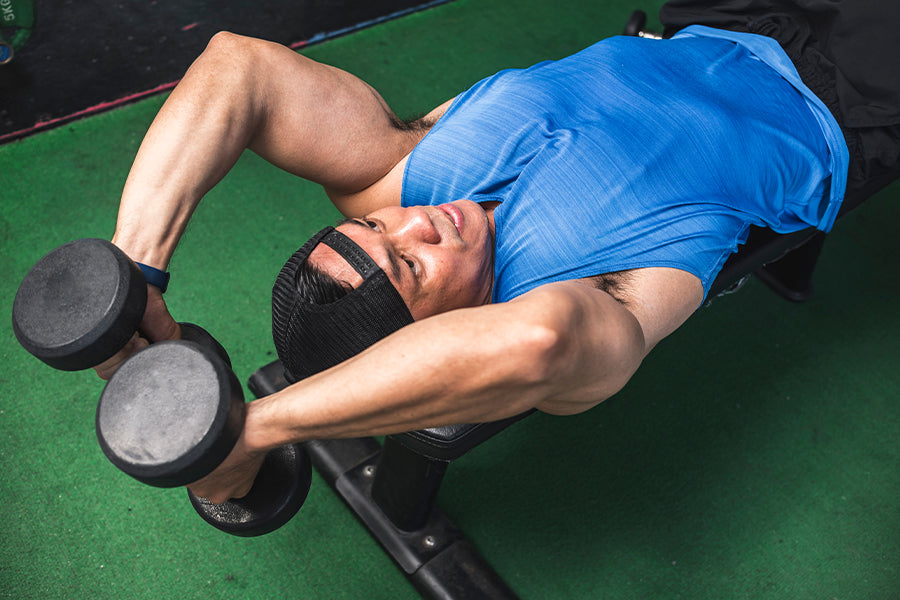Names of most exercises are pretty descriptive: A good analogy would be single-arm overhead dumbbell extension. Other types, though, are given names based on the portion of the body they're likely to crush if you let go of them. Skullcrushers are part of this group.
In a triceps isolation exercise, the skull crusher focuses on strengthening that muscle group at the rear of the upper arm. It's a great addition to a routine that increases muscle in the upper body.
In the next section, we go further into the skull crusher to offer form advice, highlight advantages, and present alternatives and variants tailored to best suit your training requirements.
What is a Skull Crusher?
Whether you know it as a skull crusher or a lying triceps extension, this move targets your muscles specifically and is an excellent example of isolation training.
Skull crushers are done by laying on one's back on a flat bench, stacking the dumbbells overtop of one’s shoulders and flexing and extending the elbow, lowering the weight towards one’s skull for reps.
When performed correctly, this strength training move may target other muscle groups and the triceps, including the deltoids and latissimus dorsi. You may also do a dumbbell skull crusher, a variant that uses dumbbells instead of a barbell or kettlebells.
The skull crusher should be performed with proper weight control for 2-3 sets of 10-12 reps. Choosing a weight that keeps your form intact throughout the workout is essential. Learn the exercise properly by using lesser weights and a spotter at first.
Following are the steps on how to do a skull crusher:
- On a flat gym bench, lie on your back. Your complete body should be positioned on the bench, except for your legs.
- Your feet should lie level on the ground, and your knees should be bent. Both hands hold one end of a dumbbell, the arms are raised above the chest, and the elbows are spread apart but not locked.
- Now lower the weight toward the top of your head by flexing your elbows. Your upper arms should continue to be almost aligned with your torso. This prevents the stress from moving from the triceps to the shoulders.
- Lower the weight farther behind the head. The bottom of the dumbbell head should be about even with the top of the bench or even a little higher if it is too hard to control.
- Counteract the motion until the weight is in the original starting position—above the chest. To keep your triceps muscle taut, avoid locking your elbow.
- Repeat.
When doing skull crushers, grip one dumbbell in each hand. If you'd like extra weight, you may use a barbell with weights attached to each side.
Muscles Engaged in Skull Crushers
The triceps are the intended focus of the skull crusher, a single-joint exercise. The skull crusher is an isolation exercise for the triceps, as opposed to the compound exercises like the close-grip bench press and dips.
However, the advantages extend to another major but sometimes ignored muscle group.
Triceps
The triceps are involved in pushing because of their role in elbow extension (bench presses, overhead presses, push-ups, dips, overhead stability, etc.). The skull crusher isolates the triceps by requiring the lifter to flex their elbows deeply while keeping their wrist and shoulder joints stable.
Shoulder Stabilizers
The rear deltoids and scapular stabilizers work hard to stabilize the shoulder socket so the lifter can stay in a stable position. By restricting shoulder movement, the lifter can increase the demands placed on the triceps to extend the elbow joint completely by forcing the elbows to flex to obtain the requisite range of motion.
Benefits of Skull Crusher
Here are several advantages lifters can expect from using the skull crusher in their workouts.
Develops Triceps
Triceps strength is essential for overhead support and pushing motions. Triceps strength is crucial for powerlifters since it helps when trying to lock out of the bench press. Also, strongmen who can lift logs weighing over 300 pounds overhead rely heavily on their triceps muscles to accomplish the move.
The more you lift weights as you get stronger, the more important your triceps will become.
Related Article: The Best Tricep Exercises for Beginners
Stronger Elbows
Healthy joints are typically the result of adequate training volume, technique, and increased muscle hypertrophy and force output. This allows training volumes and loads to be absorbed by the muscles rather than placed on the tendons, ligaments, and joints.
It is essential to have stronger triceps in addition to adopting the correct form to maximize pressing performance while reducing the risk of overuse injury to the joints and connective tissues.
Shredded Arms
Developing larger, more toned arms is a secondary objective for many strength and power competitors. Because the triceps make up around two-thirds of the arm, focusing more of your training efforts on those muscles could help you develop a more impressive set of pipes.
Skull Crushers Variation
Modifying the skull crusher in even little ways may profoundly affect the nature of the stimulation and the benefits you get from it.
Barbell Skull Crushers

Lying triceps extensions with a barbell may be more comfortable for specific individuals than with a dumbbell. Keep in mind that utilizing a barbell increases the stress on your wrists. Before lifting with a barbell, you may need to work on your wrist strength.
- Start in the same starting position as the dumbbell skull crusher.
- As you lower the barbell toward your forehead, tuck your elbows in as far as possible.
- Slowly and deliberately lower the barbell from behind your head once it has reached your forehead. As you finish this motion, your shoulders will drop, and your arms will roll back. You will feel a stretch at the back of your arm.
- Lift the bar back to your starting position, following the same path of movement the bar took on the way down.
- Repeat.
Incline Skull Crusher

When using the incline bench skull crusher, the weight is lifted while the bench is slightly slanted (barbell, dumbbell, kettlebell, etc.). With an incline, you may train your triceps from various angles and get a somewhat deeper stretch.
- Set up an incline bench to around 30-45 degrees, and choose the dumbbells you wish to use for the incline skull crusher.
- Take a seat on the bench.
- Hold the dumbbells with your hands slightly closer than shoulder-width apart in an overhand hold with your palms facing down.
- With your arms completely extended and the dumbbells held straight up in the air, recline back on the bench.
- Slowly lower the dumbbells until it is nearly in contact with your forehead.
- After pausing, carefully raise your arms to their initial posture.
Common Mistakes
Since you're only using one muscle, it might appear foolproof, but the skull crusher can quickly go wrong. Avoid these frequent mistakes if you decide to include them in your program.
Using Too Much Weight
While there is no such thing as a completely safe workout, the skull crusher can strain your wrists and elbows. Also, depending on where you fail, the movement configuration may not allow you to complete the set if things go wrong safely.
Due to these limitations, the skull crusher is not a good choice for a heavy-load lifting routine. Your triceps will respond well to a modest load and a strong muscle contraction.
Forcing a Correct Form
There is no one right way to do the skull crusher since everyone has various-sized shoulders, wrists, and elbows. There is no need to endure the discomfort of utilizing a straight barbell if doing so causes discomfort or strains your joints.
Using a cambered bar or even dumbbells might make the workout far more manageable and in tune with your unique body.
Shaky Grip
Hold tight to avoid injuring your head or face if the weight slips out of your hands. If this bothers you, you should work on your grip strength before doing this.
Safety and Precautions
There is a risk of elbow pain if you perform this workout. If you have previously suffered from an elbow injury, such as tennis elbow, you should steer clear of this exercise. Stop doing this exercise immediately if you have any pain in your elbows at any moment.
Perform only a few repetitions of this exercise to begin. As your strength increases, you should gradually perform three to five sets of lying triceps extensions, each including between six and twelve repetitions. If you plan on lifting with a barbell, you should always have a spotter nearby in case of any problems.
Related Article: Injury Prevention: 7 Ways to Stay Injury-Free for Life
Final Words
Exercises for the triceps appear to be straightforward, but to experience the most degree of success, you need to perfect the mechanics behind them. The skull crusher is an excellent exercise for developing beefy arms, and if performed correctly, it can surpass other options. Now that you have mastered barbell skull crushers and can perform them efficiently, it is time to focus on increasing the size of your arms. Let's do some exercise today! As soon as you include these into your routine consistently, you will notice improvements in your fitness and other aspects of your life.








